Connections for the STEM Classroom
Saving Biodiversity to Save Our Life-Sustaining Biosphere
A review of the report “Living Planet 2022: Building a Nature-Positive Society”, World Wildlife Fund, 2022.
By Ian Stone1, Tony Weinke2, Kaylynne Dennis2, Nate Dugener2, Clarisse Odebrecht3, Juanma Medina-Sánchez4 and Bopi Biddanda2
1School for Environment and Sustainability, University of Michigan, USA
2Annis Water Resources Institute, Grand Valley State University, USA
3Instituto de Oceanografia, Universidade Federal do Rio Grande, Brazil
4Departamento de Ecología, Universidad de Granada, Spain
A new report chronicles the unprecedented scale of ongoing world-wide biodiversity loss under anthropogenic stressors and climate change, and lays out detailed plans on what humanity should do – including recognizing the rights of Indigenous Peoples and utilizing the value of indigenous knowledge systems – to conserve extant biodiversity, enable ecosystems to recover and save our biosphere.
“You are undone if you once forget that the fruits of the earth belong to us all and the Earth itself to nobody” – Rousseau, J-J. (1754).
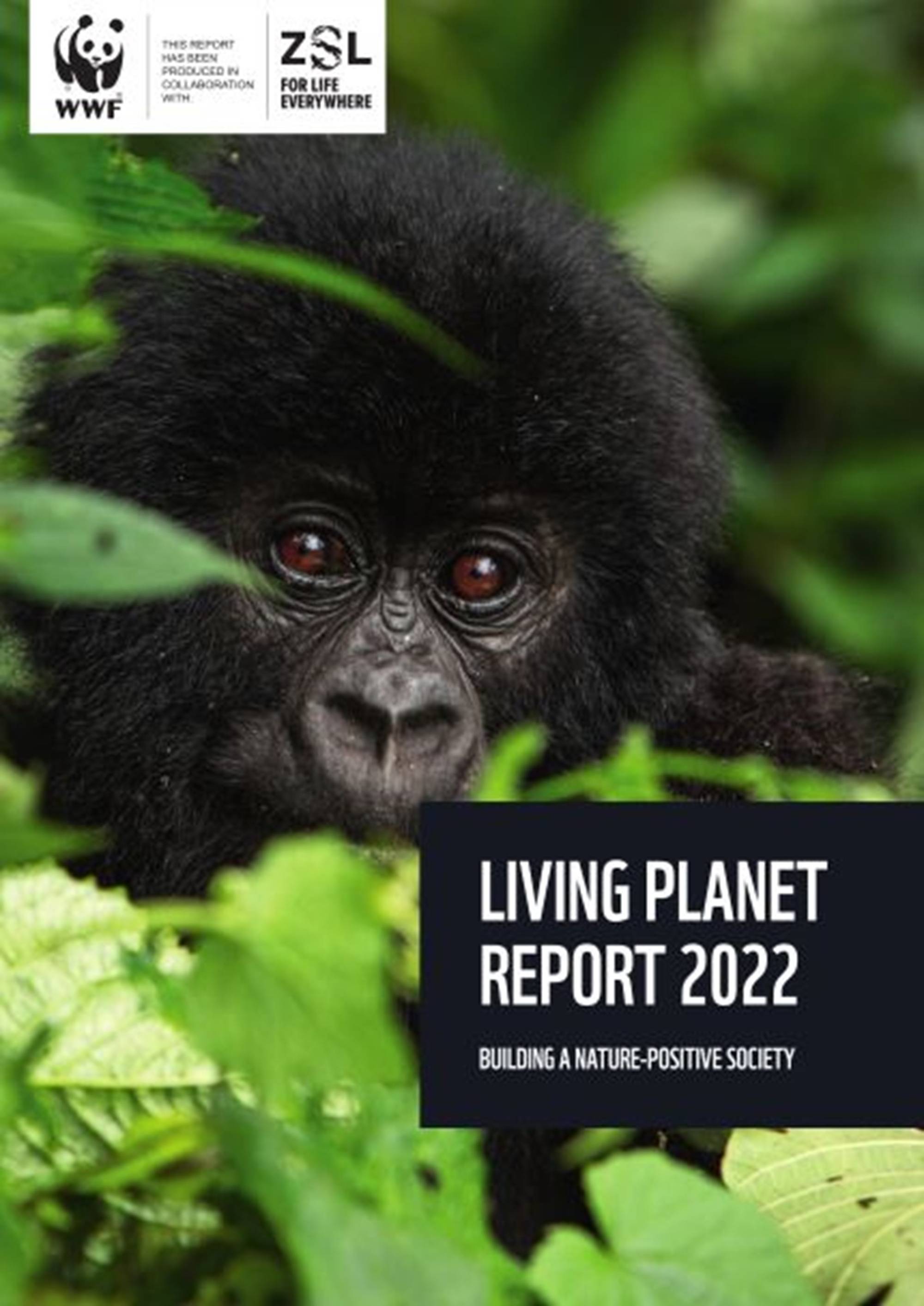
Figure 1. Cover of the report under review. World Wildlife Fund (WWF), “Living Planet Report 2022: Building a Nature-Positive Society” (2022). https://www.wwf.org.uk/our-reports/living-planet-report-2022
The Living Planet 2022 Report: In order to know the status of the Earth as a life-sustaining planet, it is essential to know where we have been, where we are now and where we are headed. Taking stock of worldwide animal populations, often relegated to an afterthought behind widespread climate change, tells a haunting story of the loss of wildlife over recent decades that is in lockstep with humanity’s ever-increasing footprint on nature. The Living Planet Report 2022 (Figure 1) demonstrates in stunning graphics, personal vignettes, and easy-to-digest terminology that the “interlinked emergencies of human-induced climate change and the loss of biodiversity” are just that, emergencies. Like any emergency, change is needed fast. Transformational change. Change that puts humanity on a route to live harmoniously within the biosphere by building a nature-positive society (Figure 2).
[1681177666].jpg)
Figure 2. The report at a Glance. Image is taken from pages 12 and 13 of the WWF report under review.
The Linked Climate-Biodiversity Problem: Biodiversity – the abundance of species on our planet, is much more than just a box of the variety of life. Biodiversity protects ecosystems against declines in their functionality and allows for adaptation to changing conditions. High biodiversity in ecosystems is also correlated with high productivity as well as relative stability – think rain forests and coral reefs. Indeed, biodiversity is the biosphere’s “insurance policy” wherein functional redundancy conferred by high biodiversity combined with an even distribution among its functionally redundant members confers ecosystems a high degree of stability and resiliency against the inevitably oncoming changes (Naeem 2009; Wittebolle and others. 2009; Midgley, 2012, Marselle and others. 2021). Agriculture and other anthropogenic land use changes are known to reduce biodiversity (e.g., electing for dominant species and introduction of invasive species) and result in reduced evenness, whereas conservation of ecosystems is known to increase both biodiversity and evenness. Biodiversity-rich ecosystems being more productive, more stable and more resilient than their comparably diversity-poor counterparts is a well-tested, ecological concept (Figure 3).
“Humanity will eventually pay a very high price for the decimation of the only assemblage of life that we know of in the universe” – Ceballos, Ehrlich and Dirzo (2017).
[1681177944].jpg)
Figure 3. A simplified conceptual diagram of the known relationships among biodiversity, ecology and economics on the planet. Biodiversity and ecosystem function are inextricably linked. Biodiversity loss impacts ecosystem functions and services, leading to further loss in diversity and negatively affecting human health, economics and climate. Restoring biodiversity can reverse these negative impacts. Information source for this diagram is from Naeem (2009), Wittebole and others (2009), Midgley (2012), WHO (2015), Marselle and others (2021), and Dasgupta (2021).
Worldwide, ecosystems are becoming dominated by one or a few species, and the ecosystem services they provide are becoming less resilient to stresses such as anthropogenic land-use change, pollution and climate change (Millennium Ecosystem Assessment, 2005). Today, humans and livestock far outweigh wild mammals and birds together in terms of biomass; and of the world’s mammals, livestock and humans comprise 96% – leaving just 4% for mammals in the wild (The Guardian, 2022) – greatly skewing the distribution of biomass and species on the planet. Indeed, a more recent world-wide study pins this skewed biomass squarely on human destruction of wilderness and other consequences of human activities including climate change (Greenspoon and others, 2023).
However, the global biodiversity crisis tends to take a backseat to the climate crisis in the ethos of western society. What’s more, each of these crises are often compartmentalized as two distinct problems when in reality, the two are inextricably linked – and are “two sides of the same coin” (see page 16). This double-edged sword is a global problem, not only in geographic scale stretching from pole to pole and land to sea, but also in social ambit by pervading every sector and discipline. While the leading cause of biodiversity loss to-date has been habitat loss and fragmentation, even the low-end greenhouse gas emission scenarios for 2100 by the Intergovernmental Panel on Climate Change (IPCC) result in climate change surpassing fragmentation as the primary cause of biodiversity loss (IPCC 2013). Similarly, this biodiversity loss contributes to exacerbated and accelerated climate change (Figure 2, 3). The looping interactions of climate change->biodiversity loss->climate change->biodiversity loss are often complex, unclear, and abstract, but the Living Planet Report 2022 excels at using small vignettes to clarify the opaque interactions of biodiversity and climate change.
“We are currently trashing nature like there was no tomorrow. I think it is a massive mistake to think of nature as an infinite source of goods and services” – Partha Dasgupta (2023).
Insights into Biodiversity Loss from the Living Planet Index: Unraveling a problem of this size requires data, and lots of it. Authors of this report gathered and synthesized available data, incorporating ~32,000 species of vertebrates in its Living Planet Index to paint a fuller picture of the situation at hand. The Index is constructed by calculating an average trend for tens of thousands of terrestrial, freshwater and marine vertebrate populations in the wild across the globe. The growing body of data in this edition of the report succinctly highlights the variations in biodiversity risk across regions as well as the differences between and within major taxonomic groups in extinction risk and recovery (Figure 4). Previously overlooked areas of important biodiversity such as within freshwater ecosystems are explicitly covered, but maps such as those showing connectivity and hotspots of risk fail to reach beyond the terrestrial into the marine and freshwater to create a truly global picture.
While rendered and displayed beautifully, the message from the data is less rosy: The speed and scale of the biodiversity crisis is uneven but widespread and largely accelerating (The Guardian, 2022). However, this far-reaching data analysis allows for easy comprehension of what places are the most vulnerable. For example, over the last 5 decades, vertebrate average population abundance declined by 94% in Latin America and the Caribbean (highest of any bioregion) and by 83% in freshwater habitats globally (highest of any other habitats such as forests and oceans) – suggesting tropical deforestation may have the greatest impact on biodiversity loss and that freshwater bodies may be disproportionately susceptible to species loss. The report also identifies ~36 globally distributed biodiversity hotspots that deserve conservation as future cradles of life in a planet with dwindling biodiversity. Knowledge that the distribution of biodiversity and biodiversity loss is uneven across the planet is invaluable information for decision makers working towards sustainable solutions for the future.
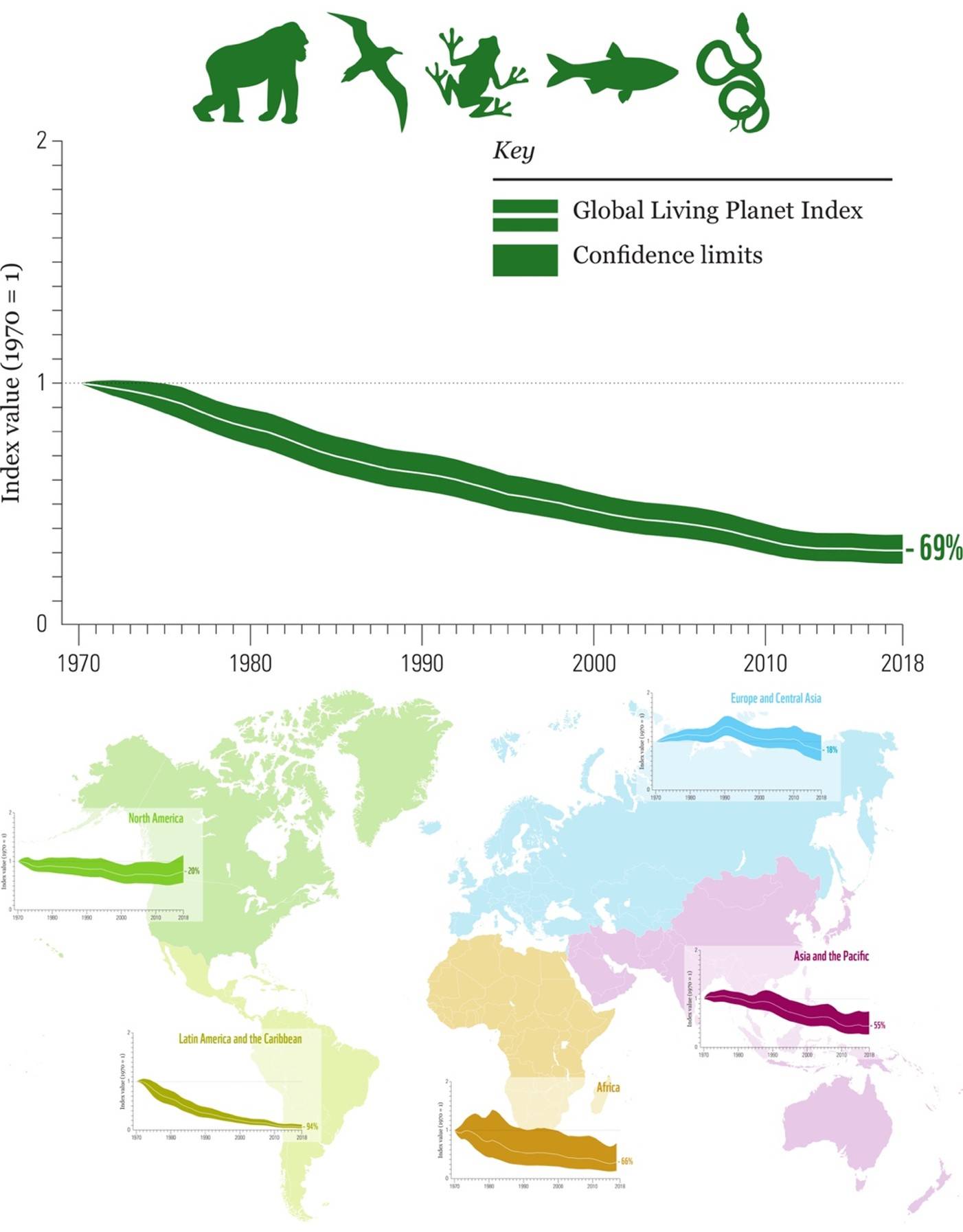
Figure 4. Living Planet Index 1970-2018 (https://www.livingplanetindex.org), acts as an early warning indicator of the changing trends in the distribution and abundance of vertebrates (mammals, fish, reptiles, birds and amphibians) demonstrating that the risk of biodiversity loss is not spread equally around the world. The bold line shows the index values and the shaded areas represent the statistical certainty surrounding the trend (95%). The global index represents 31,821 populations of 5,230 species. All indices are weighted by species richness, giving species-rich taxonomic groups in terrestrial, marine and freshwater systems more weight than groups with fewer species. Whereas the global index shows an average decrease of 69% in wildlife over the last 5 decades, Latin America and the Caribbean showed the largest decline (94%) and freshwater species are disproportionately affected (83% decline). Images are taken from pages 32, 34 and 35 of the WWF report under review.
“Access to unprecedented amounts of data from sensors on satellites, smartphones and in situ devices can be combined with incredible amounts of computing power through advanced algorithms to help us classify, predict and make decisions about managing natural systems.”
– Lucas Joppa, WWF Living Planet Report 2022, pg. 90
Limitations of the Living Planet Index: While tracking vertebrate animal populations in the wild may be a good working measure of the overall ecosystem biodiversity, it is missing the bulk of planetary biodiversity which is composed mostly of plants, fungi, invertebrate animals, and microorganisms. Indeed, “the economics of biodiversity is the economics of the entire biosphere” (Dasgupta, 2021), and understanding the incredible complexity of ecosystem processes driven by the diversity of life requires analyzing and adequately valuing the entire biosphere. The high rates of decline observed among the major vertebrate taxonomic groups suggests that similar declines in non-vertebrate taxonomic groups may be occurring. However, at the present time, we do not know if rates of decline in populations of vertebrates can be reasonably extrapolated to the other kingdoms of life in order to more fully assess the global consequences of biodiversity loss. Further considerations involve the insidious effect of the indiscriminate loss of a multitude of animal, plant and microbial species being caused by just one species – countless species utilized for food, medicine, intrinsic value, and other natural resource value are being lost forever to future generations.
Putting Indigenous Peoples at the Center of Biodiversity Conservation – A Win-Win Nature-Positive Sustainable Conservation Proposition: One of the most significant new contributions of the 2022 WWF report is the argument for a rights-based approach that all humans and non-human life has a right to a healthy environment. Specifically, the report raises the need for respecting “the rights of Indigenous Peoples and local communities to their land, freshwater and the sea” (p. 11). There is an emphatic recognition of the importance of indigenous leadership in conservation and the report argues that, “By learning from indigenous experts, we (re)open a door to an approach to conservation that respects the inherent interconnectedness between people and place” (p. 50). Indeed, many communities that are more vulnerable to the effects of climate change and biodiversity loss have already been forced to find creative solutions. From developing natural barter systems to planting indigenous crops, the report gives examples of success and resiliency at local levels, and makes clear that Indigenous Communities should be looked to for guidance and leadership during this crisis. It is notable that in many areas “vertebrate biodiversity in indigenous territories equals or surpasses that found within formally protected areas” (see page 50).
We can look to Indigenous Cultures around the world such as the Native American’s spirituality, specifically the “Seven generation stewardship”, the Great Law of the Iroquois Confederacy which is to ensure that the seventh generation from now will have adequate Nature to maintain their culture and secure their food and water supplies. Examples abound in all continents and all kinds of habitats ranging from the sea to deserts and forests of Indigenous Peoples living sustainably with their natural resources for generations. The WWF report highlights Indigenous Peoples and their relationship to the world around them and the sustainable and biodiversity conserving practices they employ. Illustrative examples in the report like the interrelationship between the Salmon life cycle and Salmon People of northeast North America (Figure 5) and the Vision of the Living and Sustainable Amazon from Amazonian Indigenous Peoples (Figure 6) demonstrate how putting their knowledge at the center of biodiversity conservation can propel long-term sustainability.
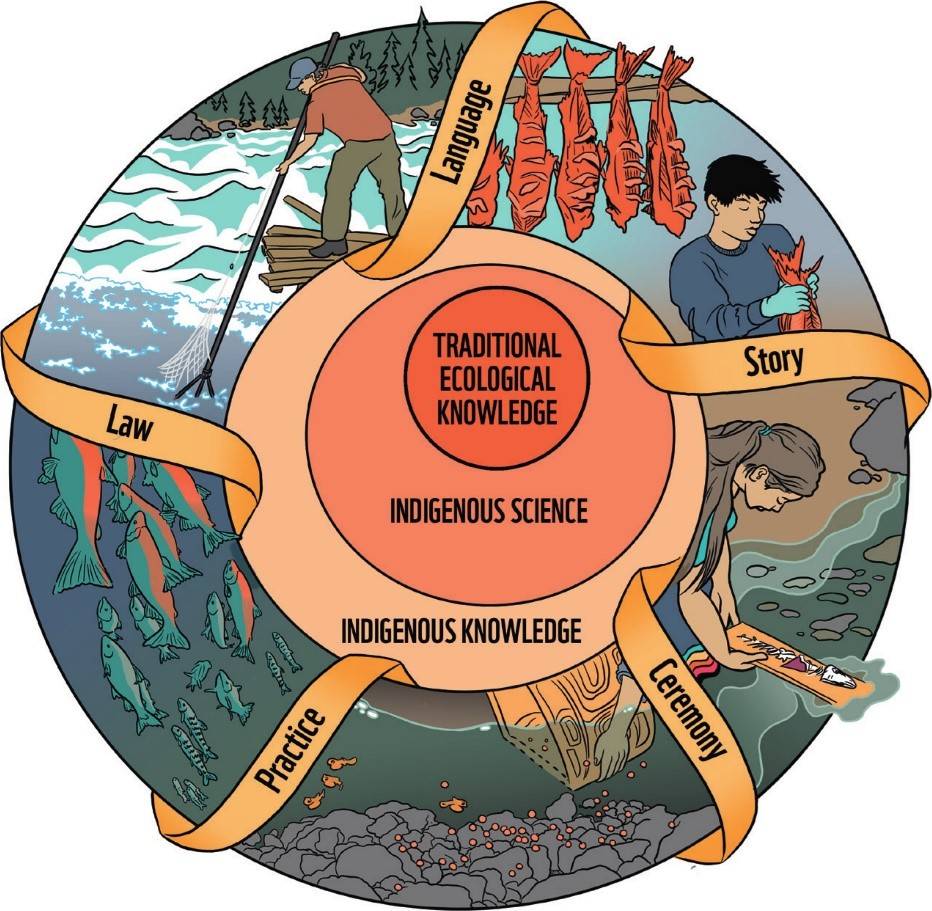
Figure 5. “Interrelationships between traditional ecological knowledge, indigenous science and indigenous knowledge systems are depicted using the symbology of the life cycle of Pacific Salmon, starting with the salmon egg at the core of the image. The understandings and philosophies embedded with this center are carried through time across generations, through language, story, ceremony, practice and law. Salmon and Salmon People not only coexist in these settings but are interdependent on one another. Source Illustration commissioned from Nicole Marie Burton.” Image and legend taken from page 51 of the WWF report under review.
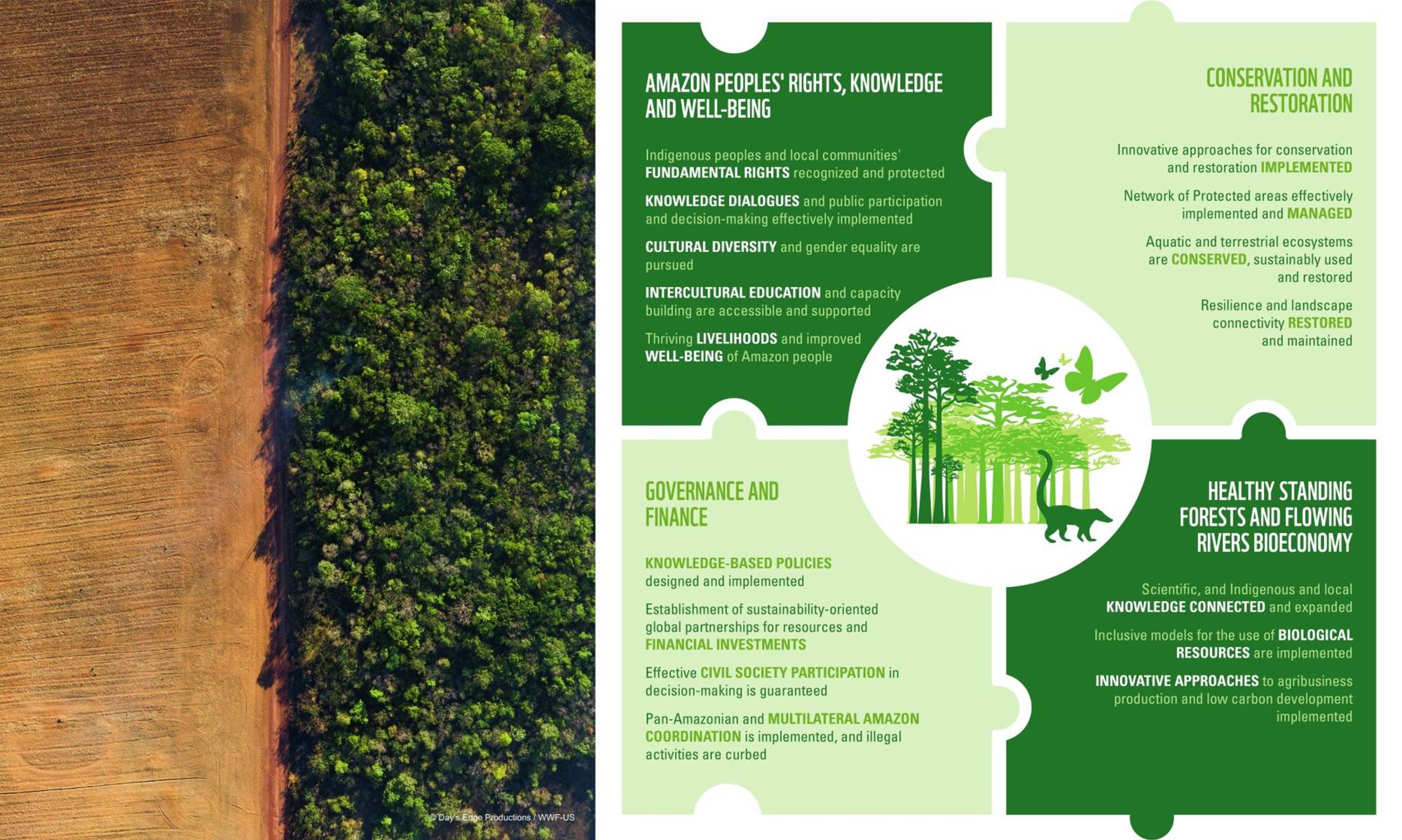
Figure 6. Side-by-side aerial view of a harvested corn field and forest under the haze of smoke from forest fires in Brazil’s Amazonia (left) and dimensions of indigenous peoples and nature-positive transformation towards the Vision of the Living and Sustainable Amazon covering indigenous people’s rights, conservation, governance and healthy forests and water (right). Images and legends are taken from pages 65 and 97of the WWF report under review.
"I stand here today to speak of the sacred bond between us and our natural world, for the respect of indigenous communities and empathy towards other living beings we share space with, and finally, coexistence" – Kartiki Gonsalves, Director of “The Elephant Whisperers” (2023).
From Nature-Human Knowledge to Sustainable Action: The 3rd and final chapter of the Living Planet Report 2022 focuses on translating the knowledge of the prior two into transformational action (Figure 7). The recent (2022) UN Human General Assembly declaration of a right to a Clean, Healthy, and Sustainable Environment is noted as an encouraging first step towards this change, although challenges continue to mount. The report excellently weaves the need for distinct sectors and disciplines to incorporate transformational change into their respective fields, from flipping economics on its head to the diversification of food systems while baking in issues of rights, equity, and the role of technology. Built upon this is the continual recognition that people play a central role in this transformation, but that individual solutions will need to be as diverse as the people that implement them.
“Multiple strategies for conservation will be needed to manage the benefits for nature and people.”
– Rebecca Chaplin-Kramer, WWF Living Planet Report 2022, pg. 48.
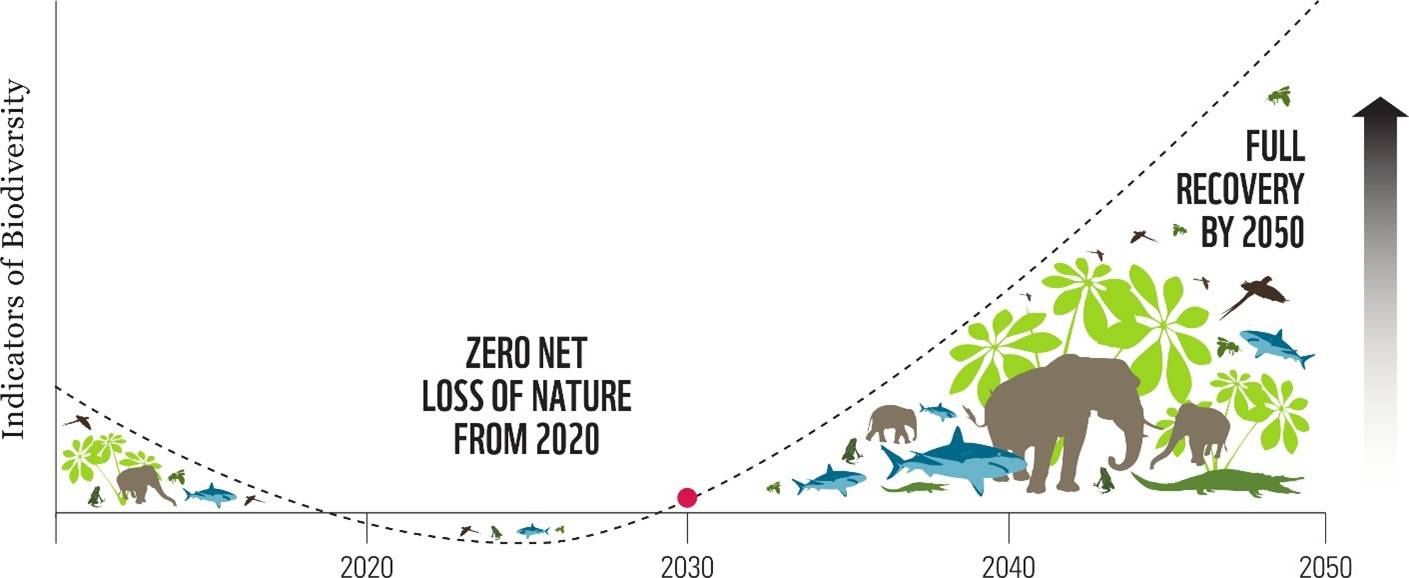
Figure 7. Nature Positive by 2030: A measurable goal for reversing biodiversity loss by 2023 to secure a nature-positive world. Image is taken from page 101 of the WWF report under review.
Acting on the biodiversity crisis at a global scale opens the door for a suite of tough questions, many of which are discussed in this report. Concerns similar to those of the climate crisis abound: Who’s responsible? Who should pay? How do you ensure compliance? What areas do you protect? What should be the goal? How do you facilitate coordination between countries to address connectivity? Luckily for us, the oft-referenced COP15 (United Nations Biodiversity Conference) now gives us the benefit of hindsight on some of these issues. As the flip side to the coin of climate, it’s only fitting that many of the answers provided by COP15 emulated the country-to-country flexibility provided by the 2015 Paris Accord. Encouragingly, key messages and recommendations of the Living Planet Report 2022 were incorporated into the agreement, including the protection of 30% the world’s lands and waters and no net loss in high-biodiversity areas by 2030. Nevertheless, the transformational changes necessary to meet the biodiversity challenges will be achieved remains to be seen (BBC 2022; Gilbert 2022; UNEP 2022).
In the emerging Anthropocene – that is also becoming infamously known as the age of the 6th mass extinction (Ceballos and others, 2017), the collective choices we humans make will shape the climate and biodiversity outcomes of the future. Mitigating ongoing climate change and reversing biodiversity loss are not impossible. In recent decades, many species such as the Iberian lynx and the Puerto Rican Amazon parrot have been rescued from the brink of extinction by conservationists. Nature has repeatedly demonstrated that if given the chance, it can and will recover. Only once we prioritize our needs over wants, realize that we are embedded in nature, recognize that we cannot exist without Nature’s life-giving services, and change the paradigms of economics to fully incorporate the cost of damages we are inflicting on nature/biodiversity, can we begin the path to recovery (Dasgupta, 2021). In the words of the former secretary of the UN Framework Convention on Climate Change, Christiana Figueres, “we hold in our hands the pen of history in this decisive decade” (Figueres 2023). The most recent report of the IPCC reiterates these concerns and the need for urgent and coordinated action to avert the dual impact of biodiversity loss and climate warming (Climate Change 2023: A Survival Guide, IPCC, 2023). How humanity now comes together – or not – to tackle the urgent and ubiquitous dual challenge of climate change mitigation and biodiversity conservation, will determine the future trajectory of our civilization on this living planet – the only life-sustaining home that we have.
“Utopia signifies not the unrealizable, but the unrealized. Yesterday’s utopia could turn into today’s reality” – Theodore Monod (~2001).
Additional Reading:
- BBC. Biodiversity: Can we set aside a third of our planet for nature? Dec. 2022. https://www.bbc.com/news/science-environment-63955526
- Ceballos, G., P. Ehrlich, and R. Dirzo. Biological annihilation via ongoing sixth mass extinction signaled by vertebrate population losses and declines. PNAS, UAS, 2017 https://doi.org/10.1073/pnas.17049491
- Dasgupta, P. 2021. The Economics of Biodiversity: The Dasgupta Review. (London: HM Treasury).
- Dasgupta, P. 2023. https://www.nytimes.com/2023/03/28/opinion/alexander-skarsgard-partha-dasgupta-economy.html
- Figueres, C. We hold the pen of history. TIME Jan. 30/Feb. 6, 2023, p. 50.
- Gilbert, N., “Nations forge historic deal to save species: what’s in it and what’s missing”. Nature, Dec. 19, 2022. https://www.nature.com/articles/d41586-022-04503-9
- Greenspoon, L. and others. 2023. The Global biomass of wild mammals. PNAS, USA, 120 (10) https://doi.org/10.1073/pnas.2204892120
- IPCC, 2013. “Summary for Policymakers,” in Climate Change: The Physical Science Basis. Contribution of Working Group I to the Fifth Assessment Report of the Intergovernmental Panel on Climate Change (Cambridge University Press, 2013). https://www.cambridge.org/core/books/abs/climate-change-2013-the-physical-science-basis/summary-for-policymakers/356E277FD1FBC887845FB9E8CBC90CCD
- IPCC, 2023. “Climate Change 2023: A Survival Guide”. Sixth Assessment Report of the Intergovernmental Panel on Climate Change (Cambridge, UK: Cambridge University Press, 2023). https://www.ipcc.ch/report/ar6/syr/
- The Guardian. The biodiversity crisis in numbers – a visual guide. Dec. 2022. https://www.theguardian.com/environment/2022/dec/06/the-biodiversity-crisis-in-numbers-a-visual-guide-aoe
- Millennium Ecosystem Assessment. 2005. Ecosystems and Human Well-Being: Biodiversity Synthesis. World Resources Institute, Washington, DC.
- Midgley, G. F. (2012). Biodiversity and Ecosystem Function. Science, 335(6065), 174–175. doi:10.1126/science.1217245
- Marselle, M. R., Hartig, T., Cox, and others (2021). Pathways linking biodiversity to human health: A conceptual framework. Environment International, 150, 106420. doi:10.1016/j.envint.2021.106420
- Naeem, S. 2009. Gini in the bottle. Nature 458: 579-580.
- UN Environment Programme (UNEP). COP15 ends with landmark biodiversity agreement. Dec. 20, 2022. https://www.nature.com/articles/d41586-022-04503-9?WT.ec_id=NATURE-202212&sap-outbound-id=7C30B1E8E794E4113D8BC6ECC931BA593017A850
- WHO 20215. Connecting global priorities: biodiversity and human health: a state of knowledge review. World Health Organization and Secretariat of the Convention on Biological Diversity, 2015. ISBN 978 92 4 150853 7
- Wittebole, L. and others. 2009. Initial community evenness favors functionality under selective stress. Nature 458: 623-626.
[1681179088].jpg)

